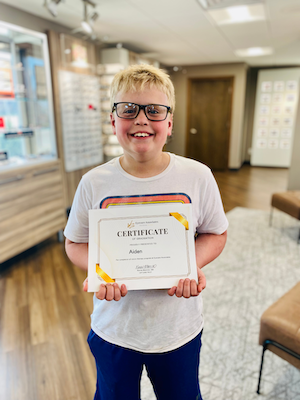Summer 2023 Newsletter
Vision Therapy and Rehabilitation News
Tech Corner
At Eyecare Associates, we always try to be at the forefront of technology. We are excited to have the RightEye Vision System in our office. This computerized, infrared eye tracking device allows us to measure the dynamic vision skills that impact the quality of your life.
Functional vision is how well the eyes and the brain work together to process what is seen, and this essential aspect of vision isn’t always evaluated in a traditional eye exam. When your dynamic visual skills aren’t addressed, it can negatively impact your everyday life, including activities such as driving, reading, having good balance and coordination or playing a sport.
Through a quick assessment, the RightEye is able to:
- Record and illustrate possible deficiencies in reading
- Compare reading metrics against similar grade-level peers
- Understand eye movements while reading
- Evaluate accuracy of object tracking
- Quantify eye-hand reaction time
Convergence – a common vision problem
What is convergence insufficiency (CI)? Convergence insufficiency is a common, yet not frequently diagnosed eye condition that affects how the eyes work together when reading or doing close work.
Convergence insufficiency affects up to 13% of people – that’s 1 in every 8 kids and adults!
Kids and adults can have CI and not even realize it! Here are some of the common symptoms:
- Eyestrain or tired eyes
- Headaches
- Blurred or double vision
- Difficulty reading and concentrating
- Squinting, covering or closing one eye
- Poor sports performance or coordination
- Motion Sickness
The good news is that if you or someone you know is diagnosed with convergence insufficiency, it is treatable! Both the American Optometric Association and the Convergence Insufficiency Treatment Trial clearly indicate that office-based vision therapy supplemented by at-home activities assigned by a doctor are the best treatment for CI.
If you recognize some of these symptoms, the first step is scheduling a comprehensive eye examination. Schedule an appointment today.
Success Story
 Aiden was 8 years old when he reported some blurry and double vision at his regular eye examination with Dr. Chadderdon at Eyecare Associates. Dr. Chadderdon realized that this was related to a condition called convergence insufficiency, which impacted how Aiden’s eyes worked together. Aiden started vision therapy with Dr. Monroe and was making good progress to reduce his double vision when an unfortunate ATV accident sent Aiden to University of Iowa Children’s Hospital with multiple injuries including skull fractures and a type of a brain injury called a diffuse axonal injury. With excellent medical care and support from his family, Aiden was able to recover from his injuries. As he returned to school, Aiden also returned to vision therapy. While his accident had increased some of his symptoms and slowed his progress a bit, Aiden kept a positive attitude.
Aiden was 8 years old when he reported some blurry and double vision at his regular eye examination with Dr. Chadderdon at Eyecare Associates. Dr. Chadderdon realized that this was related to a condition called convergence insufficiency, which impacted how Aiden’s eyes worked together. Aiden started vision therapy with Dr. Monroe and was making good progress to reduce his double vision when an unfortunate ATV accident sent Aiden to University of Iowa Children’s Hospital with multiple injuries including skull fractures and a type of a brain injury called a diffuse axonal injury. With excellent medical care and support from his family, Aiden was able to recover from his injuries. As he returned to school, Aiden also returned to vision therapy. While his accident had increased some of his symptoms and slowed his progress a bit, Aiden kept a positive attitude.
Aiden recently graduated from vision therapy, and is doing great. Prior to vision therapy, Aiden saw double vision when he was reading most of the time and reported that he lost concentration while reading leading him to have trouble remembering what he read. At the conclusion of vision therapy, Aiden was happy to report that he no longer had any double vision when reading, and it is much easier for him to stay focused and remember what he reads. He has also significantly improved his reading speed at school. Way to go Aiden!
Just like Aiden, many people don’t realize that vision could be the cause of their struggles. If you or someone you know isn’t performing up to their potential, take the symptom quiz by or schedule an appointment. Vision might be the key to unlocking their full potential!
Visit bit.ly/symptomquiz to take the symptom quiz.
